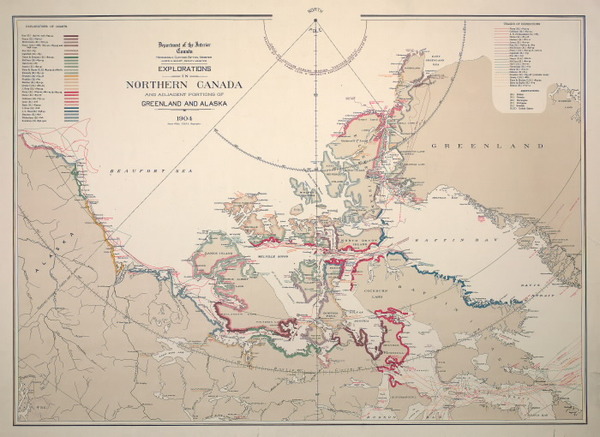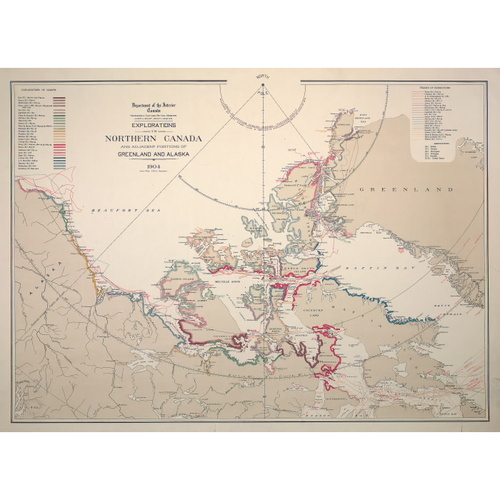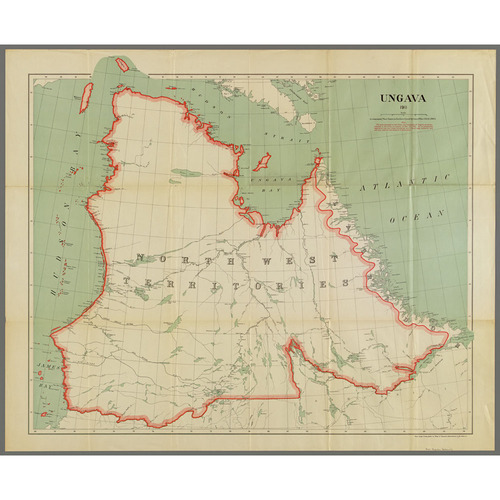WHITE, JAMES, geographer and civil servant; b. 3 Feb. 1863 in Ingersoll, Upper Canada, eldest son of David White, a merchant, and Christina Hendry; m. 12 Oct. 1888 Rachel Waddell in Ottawa, and they had two daughters; d. there 26 Feb. 1928.
Educated first in Ingersoll, James White graduated in 1883 from the Royal Military College of Canada in Kingston. After joining the Geological Survey of Canada in January 1884 as a topographer, he undertook work in the Rocky Mountains, Ontario, and Quebec. Mount White (Alta) was named for him by George Mercer Dawson*, the assistant director of the Ottawa-based GSC. In June 1894 White became the survey’s geographer and chief draftsman, in succession to Scott Barlow, son of GSC cartographer Robert Barlow*.
White was promoted in June 1899 to chief geographer in the Department of the Interior, which had begun issuing systematic sectional maps of Canada in 1891. There he accumulated and disseminated a wealth of knowledge: he continued the production of detailed maps – his attempt in 1902 to consolidate government map-making was effectively resisted by the GSC – and wrote or edited valuable books on altitudes, cartography, boundaries, and place-names. He regarded the Atlas of Canada ([Ottawa?], 1906), prepared under his direction and one of the world’s first national atlases, as his most important technical achievement. He also contributed to the Alaskan Boundary Tribunal in 1903 [see Sir Wilfrid Laurier*] and to investigations in 1906–7 of rapid steamship service between Britain and its Pacific possessions via Canada.
The 1900s saw the rise of the environmental conservation movement in North America, and White became one of its key protagonists in Canada. In 1909 the Liberal government of Laurier appointed him secretary of the new Commission of Conservation, chaired by former interior minister Clifford Sifton. Sifton had enlisted influential businessmen, politicians, and academics as members, but it was White, who became deputy chair in 1913, who must be credited with the daunting task of managing a body that would produce and broadly distribute more than 200 reports from 7 committees (forests; water and water-power; minerals; lands; public health; fisheries, game, and fur-bearing animals; press and cooperating organizations). The commission grew in influence as legislators, academics, and industrialists across the country acted on its recommendations, and as its popular conferences were widely reported. An outspoken administrator, in 1910 White was a strong critic of private power development on the St Lawrence waterways.
During World War I, public opinion shifted from conservation to increased production for the war effort. Sifton’s involvement waned and White faced detractors who accused the commission of excessive spending and infringing on the work of other departments. Although White’s relationships with colleagues and key ministers deteriorated, he stepped up the activities of the commission, which played a central role in negotiating the Migratory Birds Treaty of 1916. That same year he became the founding chairman of Canada’s advisory board on wildlife protection, in which position he established bird sanctuaries at Rocher Percé and Île Bonaventure, Que., and worked for Canadian sovereignty in the Arctic.
Conservative prime minister Arthur Meighen* abolished the commission, on the grounds of duplication, in the spring of 1921, when Canada was battling economic recession. Removed from the federal payroll, White was hired back the following year as a technical adviser to Sir Lomer Gouin, the minister of justice in the recently elected Liberal administration. He contributed to such important files as the Cayuga claim arbitration and the Labrador boundary dispute but his attempts to revive the commission were unsuccessful.
Throughout his career, White belonged to many scientific and professional organizations. A fellow of the Royal Geographical Society and the Royal Society of Canada, he was a sectional vice-president in the British Association for the Advancement of Science, a president of the RSC’s geology section, and chairman of the Geographic Board of Canada in 1927–28. He belonged as well to the National Geographic Society, the Canadian Society of Civil Engineers, and the American Academy of Political and Social Science.
Supporters and critics described White as a bright, ambitious, and single-minded man devoted to the sustainable management of Canada’s natural resources. He was known as well as an “indefatigable” worker and researcher whose geographic knowledge of Canada was unsurpassed. An Anglican, he enjoyed travelling, though an early leg fracture restricted his physical activity. He died suddenly at his Ottawa home at age 65.
James White supervised the preparation of a large number of maps on Canada, many of them listed in the Catalogue of the National Map Collection, Public Archives of Canada, Ottawa, Ontario (16v., Boston, 1976). Among the works that he wrote or compiled are: The topographical work of the Geological Survey of Canada ([London, 1897]); Altitudes in the Dominion of Canada, with a relief map of North America (Ottawa, 1901); Dictionary of altitudes in the Dominion of Canada: with a relief map of Canada (Ottawa, 1903); Place names in Quebec, Thousand Islands, and northern Canada ([Ottawa, 1910]); The North Atlantic fisheries dispute (Ottawa, 1911); Place-names in northern Canada (Ottawa, 1911); Place-names in Georgian Bay (including the North Channel) ([Toronto, 1913]); Boundary disputes and treaties (Toronto, 1914); Treaty of 1825: correspondence respecting the boundary between Russian America (Alaska) and British North America (Ottawa, 1915); Place-names in the Rocky Mountains between the 49th parallel and the Athabaska River ([Ottawa], 1916); Fuels of western Canada and their efficient utilization (Ottawa, 1918); Conservation in 1918 (Ottawa, 1919); and Power in Alberta: water, coal and natural gas (Ottawa, 1919).
AO, RG 80-5-0-157, no.2434. Christopher Armstrong, The politics of federalism: Ontario’s relations with the federal government, 1867–1942 (Toronto, 1981). Canadian men and women of the time (Morgan; 1912). R. P. Gillis and T. R. Roach, Lost initiatives: Canada’s forest industries, forest policy and forest conservation (Westport, Conn., 1986). M. F. Girard, L’écologisme retrouvé: essor et declin de la Commission de la conservation du Canada (1909–1921) (Ottawa, 1994; contains a detailed bibliography on White, the conservation movement, and the publications of the Commission of Conservation). H. S. Spence, “James White, 1863–1928: a biographical sketch,” OH, 27 (1931): 543–44. Standard dict. of Canadian biog. (Roberts and Tunnell).
Cite This Article
Michel F. Girard, “WHITE, JAMES,” in Dictionary of Canadian Biography, vol. 15, University of Toronto/Université Laval, 2003–, accessed December 29, 2025, https://www.biographi.ca/en/bio/white_james_15E.html.
The citation above shows the format for footnotes and endnotes according to the Chicago manual of style (16th edition). Information to be used in other citation formats:
| Permalink: | https://www.biographi.ca/en/bio/white_james_15E.html |
| Author of Article: | Michel F. Girard |
| Title of Article: | WHITE, JAMES |
| Publication Name: | Dictionary of Canadian Biography, vol. 15 |
| Publisher: | University of Toronto/Université Laval |
| Year of publication: | 2005 |
| Year of revision: | 2005 |
| Access Date: | December 29, 2025 |





